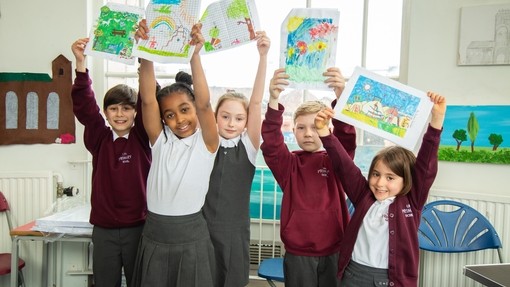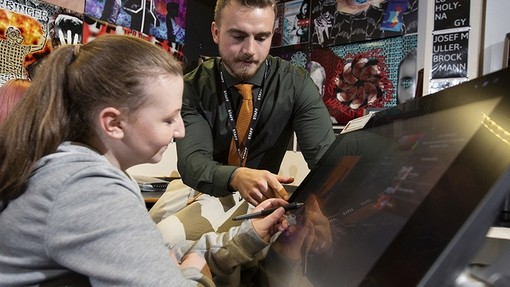
How a focus on arts can boost resilience and character
Content
Participating in arts activities can be crucial for helping pupils to gain confidence across the curriculum
Using art as a means for pupils to follow their own ideas and express themselves without a fear of being wrong can be a powerful way to build confidence, resilience and character.
Developing these attributes can then translate into other subjects to help children start to engage in lessons they may otherwise be wary of and in time become more confident learners, helping boost their educational outcomes.
Senacre Wood Primary School in Maidstone, Kent has a focus on art for these very reasons. It recently turned an old classroom into a dedicated arts space, complete with easels and picture frames for art to be displayed and arts supplies available for children to use as they want.
Deputy headteacher at the school, Maria Comerford, says engaging children in art in this way and presenting it as a means for them to express themselves has proved hugely beneficial.
“When you’re teaching core subjects there is a real sense [from the children] of danger in getting something wrong and that can sometimes hinder confidence and resilience, but with arts, children are more likely to persevere and focus and gain a growth mindset.”
The school’s art lead, Helen Clarkson, agrees and says that getting children to realise that art can be about following your own ideas and creativity can be crucial for helping them gaining confidence across the curriculum.
After one of her key stage 2 pupils who felt he was “rubbish” at art received positive feedback from staff and pupils for “a beautiful drawing of a plant” he produced, he has become much more confident in school. “Now [he is] much open to editing and redrafting writing, completing corrections in maths, for example, and he’s become much more open to new experiences - becoming more settled in our forest school sessions, our weekly swimming trips and on a recent class visit to Leeds Castle.”

Furthermore, Mrs Clarkson adds that for students with SEND, this focus on art and the flexibility it offers is especially important: “We do find that these are the children that often shine in art. It’s a subject that everyone can access and we have a big emphasis on the process, rather than the finished work.”
This has led the school to reshape much of how they teach other subjects too, to help build pupils’ confidence and learning outcomes: “The focus on the process leading to a creative outcome has been replicated across the school’s curriculum,” Ms Comerford explains.
“In English, we plan backwards from a written outcome and work towards the story [and] we have changed our humanities subjects to enquiry-based learning, where children are asked a big question at the beginning of a unit and the answer is built towards, applying the skills taught.”
Community engagement
Another Kent school focused on boosting confidence and inspiring learning using art is the Enterprise Learning Alliance. “We want students to be able to better express and manage their emotions and so we provide creative opportunities to empower them and positively influence how they learn,” says Emma-May Alton, head of art and Artsmark activity coordinator.
She cites the example of a child with anger issues who, through engaging in art lessons and developing an enjoyment of sketching, is now much better at controlling his emotions in lessons by turning to drawing. “It’s helped him realise he can find ways to control his anger,” she says.
The school has used the Artsmark framework to promote student’s engagement in community-based art projects. For example, pupils helped raise money for the Kelly Turner Foundation, an appeal for a local girl affected by cancer, by making and auctioning postcards. They also engaged in a live performance at Tate Britain during a visit to the gallery. These experiences give students confidence as they see how their exhibited art engages and inspires the public.
“When exhibiting work beyond the classroom, pupils have a unique opportunity to see how their work is received. When getting positive feedback, students often re-evaluate their mind-set as the experience validates their ideas encouraging them to continue to create and share thoughts,” says Ms Alton.
Finding success
Another positive outcome of students creating art in this way and displaying it is that it gives them a chance to promote something about themselves that isn’t related to their ‘image’, but instead focusses on their creativity and their ideas, says Ms Alton.
“To promote the events our students are involved in, we often showcase work online. This opportunity can excite students and has not only been good for boosting their self-esteem but it also helps them learn to build resilience to the different ‘reviews’ their work may receive.
“Even if there are ‘negative’ reviews it helps them learn to better manage rejection and accept that not everyone will like their art but that’s OK. This is an important lesson and contributes to them developing self-worth,” she adds.
Senacre also values displaying art in the real world, encouraging children to see themselves as artists and promoting their work in the local church, library and vets.
“We even had one of our children’s work displayed at the Turner Contemporary in Margate as part of their Art Rebels competition,” adds Ms Clarkson.
Overall the impact this has had on the children in boosting their confidence has been remarkable, with confidence among pupils notably higher having engaged in art classes. So much so that when the children were recently asked to name some of their favourite artists many of the children chose each other or proudly proclaimed, “I am an artist”.
Of course, it’s not just drawing and painting that can provide this impact. Teacher Lauran Hampshire-Dell entered many of her pupils into the Poetry by Heart competition where pupils had to learn to recite poetry: “One thing myself and all of the teachers in other schools commented on every year was how it helped students grow in confidence,” she notes. “They were able to take on something new and perform it in front of judges (who were poets), their peers, their teachers and their parents.”
She says that engaging in these kinds of activities can also give pupils who may not always be at the top academically the chance to boost their confidence and gain resilience through other means.
“There is no evidence at all that Set 1 English students will do the best recitations. This sort of feeds back in class too, as students become more confident with the curriculum if they’re occasionally able to use a more artistic perspective on something academic.”
As all the teachers here note, the key thing is that providing artistic opportunities and outlets for pupils allows them to develop, grow and express themselves in ways that may otherwise not be available in other parts of school life and this is central to letting them grow.


